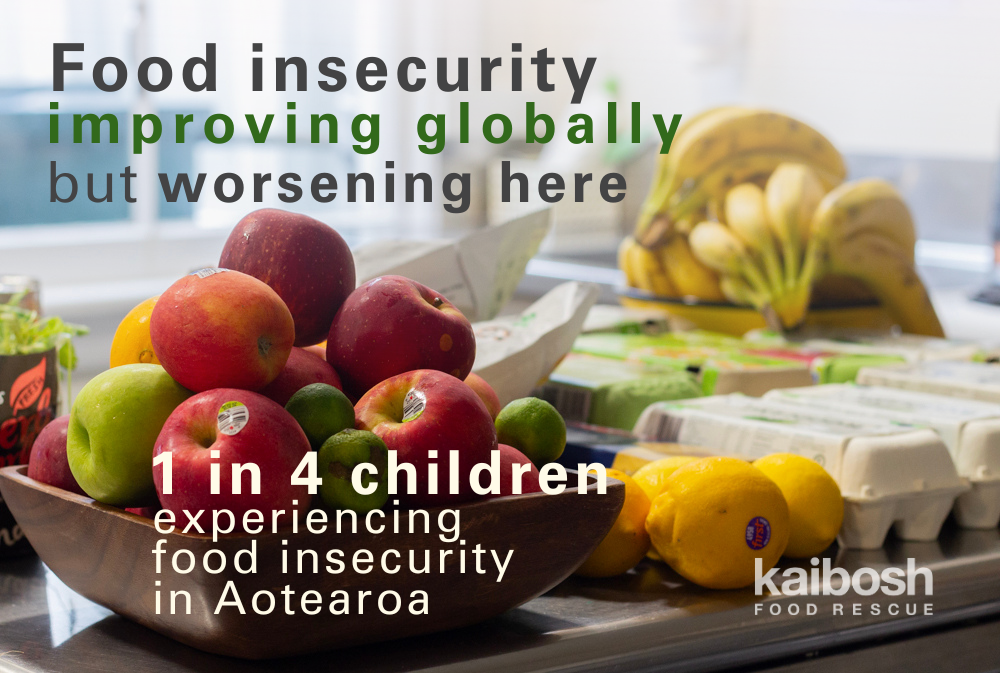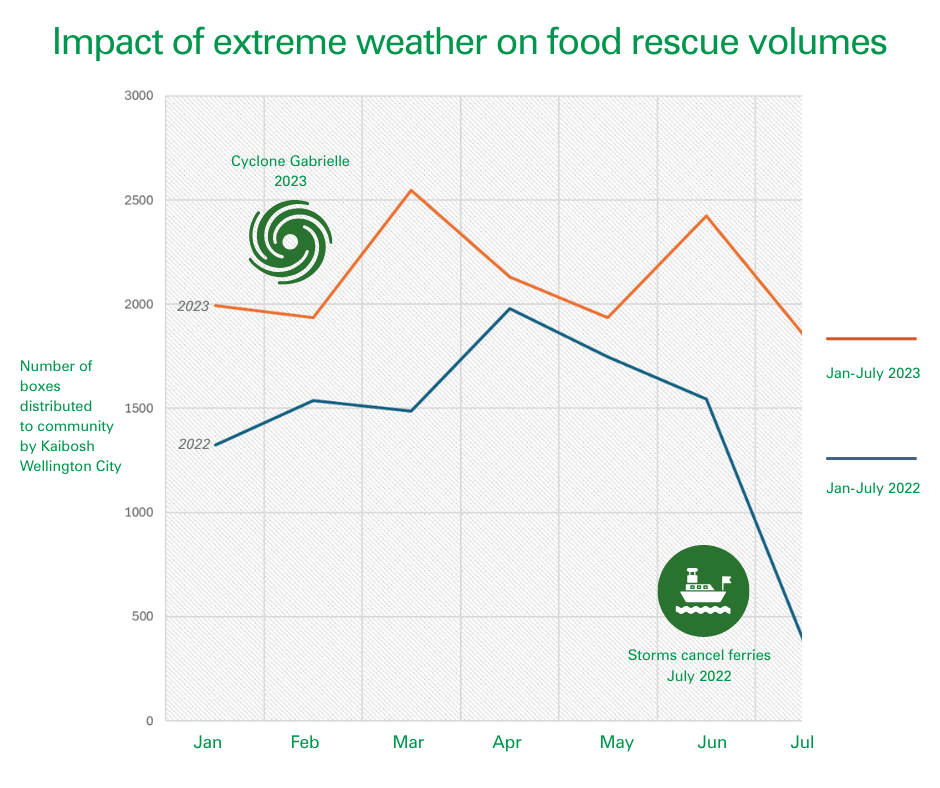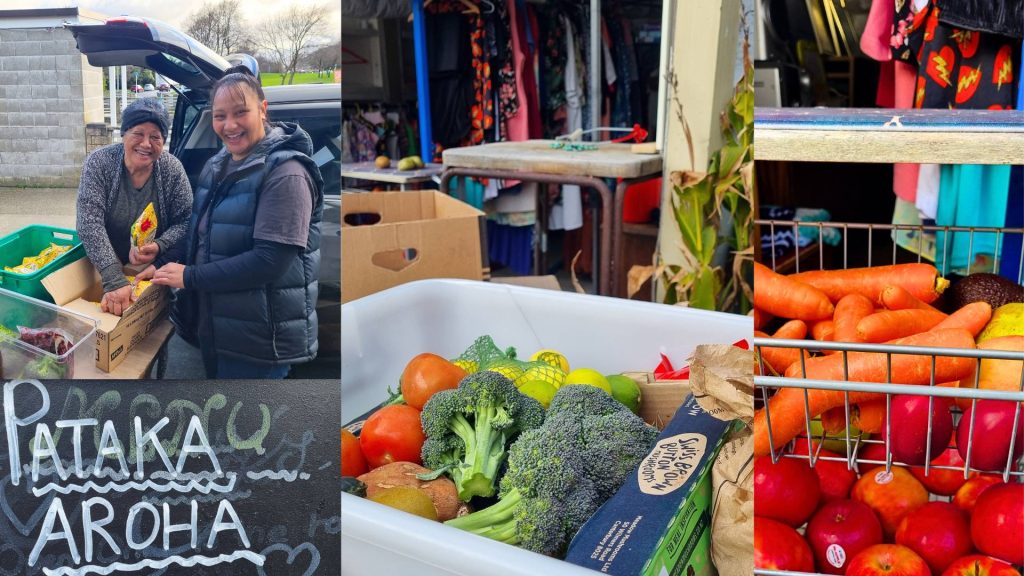How Kai Connects and Sustains Our Communities
October is World Food Day month — a time to reflect on how the way we grow, share and consume food shapes our communities and our future. This year’s theme, “Hand in Hand for Better Food and a Better Future,” resonates deeply with our mahi at Kaibosh, where food is more than just sustenance — it’s the foundation for connection, wellbeing, and resilience.
As part of a student internship with Kaibosh, Holly Watson has explored the challenges of food insecurity in Aotearoa and how community-led action, partnerships, and care are helping build stronger, more sustainable food systems. In her story, Holly shares what she learned — and the people she met — through her time with Kaibosh.
Hand in hand Kaibosh and partners are building food resilience across Wellington
What we put on our plates every day does much more than simply fill our puku – kai is the fuel that keeps our bodies running, our immune system pumping and helps heal us when we aren’t at our best. Eating a healthy mix of foods can protect us from things like heart disease, diabetes, and other chronic conditions. But here’s something many people don’t realise: food isn’t just about physical health. The nutrients we eat also play a major role in our mental wellbeing, nourishing our brain by improving our focus, memory, and other cognitive functions, as well as protecting it. However, for many whānau, this vital necessity of kai is getting harder to access and afford, and the industrial food system has inadvertently created a disconnect between the food, land and the people.
Food insecurity in Aotearoa
Globally, food insecurity has been on the decline, but here in New Zealand the situation is moving in the opposite direction. The New Zealand Food Network (NZFN) recently revealed a staggering reality; over half a million people had accessed food support in the second half of 2024 through one of the many NZFN hubs across New Zealand – with around 30% reaching out for help for the very first time. So, why is demand climbing so rapidly? The main culprits are rising living costs, low household incomes, unemployment, and those unexpected bills that hit hard when money is already tight. The bigger picture is staggering, about 27% of households with children run out of food often or sometimes across Aotearoa, highlighting how poverty and inadequate income collide with soaring housing and living expenses.

Looking into food insecurity in Wellington we can gain a snapshot into one of the main drivers – income inadequacy. The Ka Mākona report by Kore Hiakai provides an insight into the average wages in the Wellington suburb of Kilbirnie. They found that out of the total 5,080 people, 54% earn minimum wage or less and 15% earn median wage or under. These stark statistics highlight that the large majority of Kilbirnie’s population earns at or below low-middle income levels. This makes it hard for many residents in this suburb to reliably afford healthy kai. This snapshot can reflect many of the income situations for other suburbs around Wellington.
To add to this problem, the Greater Wellington Region will be subjected to population growth in the coming decades, expecting to increase by 200,000 in the next 30 years. This highlights the need to prepare by improving food security for people now and for the coming years. Supply chain shocks, such as transport disruptions and extreme weather events, are becoming more frequent in the 2020s, putting pressure on food systems.

Severe weather events impacted supply of fresh produce and other food reaching Wellington City in 2022 and 2023. Chart shows Kaibosh Wellington City food volumes between January and July in both years.
What is food rescue and how does Kaibosh work?
Kaibosh is Aotearoa’s first dedicated food rescue organisation and since 2008 they’ve been laying the foundations for others to follow across the country in addressing and tackling food insecurity. What began in Wellington was a simple but powerful idea to be the link between the food industry and community groups. This now large movement not only puts kai on the table for thousands of people every week, but drives a core sustainability mission by keeping good food out of landfill and preventing potent greenhouse gas emissions.
The heart of Kaibosh is about partnerships. They supply rescued kai to over 160 community groups and charities (2024/25 financial year) who support people in need, building relationships based on trust and collaboration. The Kaibosh team takes time to listen and build whanaungatanga with partners which has allowed them to create a system that not only works for everyone but empowers. By supporting and guiding their partners Kaibosh ensures that the excess of quality food gets to where it can be of its best value, following the food recovery hierarchy. Whether that be on to the table for whānau, or as kitchen kai to be made into a nourishing creation. If it’s not quite good enough for people, it is shared with a variety of animal-based charities or goes to local compost. This mission and drive are rooted in their value of care – care for the people, the community and the planet.

Since 2019, the number of community groups that Kaibosh supports has grown – from 109 community partners in 2019 to 164 in 2025. This is a clear signal of the need for food support in our local communities. This need is voiced in a May 2025 news article when Lower Hutt Foodbank stated that the demand for their service had “skyrocketed” over a year. What used to be a busy day at the foodbank four years ago would see 20 people, now a quiet day would be 70-80 people, and a busy day would see 135 people come in.

Since 2008 Kaibosh has rescued and redistributed more than 5.25 million kilograms of kai to the greater Wellington community. In the year July 2024-June 2025, 77% of the food rescued and distributed to community is deemed as ‘healthy fresh food types’ (57% produce, 13% dairy and eggs, 7% meat). This has consistently increased from previous years.
Innovating to strengthen local food resilience
As well as maintaining and refining these innovative solutions of food distribution, Kaibosh is also working to find gaps within these food systems to tackle. Second Harvest and Kaibosh Kitchens, projects developed since 2023, are examples of this proactive solution-based thinking that brings community together. Second Harvest is a farm-based project rescuing crops being harvested that aren’t meeting domestic or international retail standards. This food is collected from farm donors and brought into Kaibosh to be sorted and distributed to community partners. This links into the Wellington Regional Strategy. It builds community resilience by developing sustainable food networks in these coastal regions. The connections built from this provide an informal support system allowing resources to be shared. This doesn’t only apply to Second Harvest but also other initiatives such as Kaibosh kitchens. I witnessed ‘kitchen kai’ processes in action during my time at Kaibosh – from carefully choosing what is allocated for kitchen processing, to what the kai is used for. The teams use up bruised squishier produce and turn it into baked goods, soups, chutneys and many other nourishing kai that are passed on to our communities, ensuring nothing is wasted.
Connecting with community – my time at Kaibosh
From my time at Kaibosh, I knew from the very first week that this organisation did more than just tackle food insecurity. The impact of their work went beyond saving and redistributing kai, that was only the foundation. What truly stood out was how kai could connect people, strengthen wellbeing, and create opportunities. Kaibosh provides their partners good quality food regularly. This allows the partners to focus their time and resources on delivering their core service. For instance, one of Kaibosh’s community partners, Arohanui Strings+, shared that while children may first come for the kai, many end up staying for the music. They explained how the kai not only nourishes but also helps children focus and fosters a sense of togetherness.
EKTA, Te Whanganui-a-Tara / Wellington
Bringing people together is a common theme that Kaibosh’s services indirectly provide, this is in many forms like how EKTA brings the migrant community together. EKTA is a charity that was established in 2017. EKTA means unity/oneness in Hindi which encompasses this organisation’s aim of contributing to a more inclusive New Zealand. EKTA empowers people by putting on an education class, then supporting them by providing food, freeing up their money that can then be used for other needs. The community that EKTA have created has an ongoing effect, they give recipients the opportunity to give back by becoming volunteers. Thus, providing people with not only kai but skills and connections that allow these families to be more confident in the Wellington region. But without Kaibosh’s support the scale and reach that EKTA have in the Wellington region would not be possible.
Māoriland Hub, Ōtaki
When speaking to Elishka and Tania from Māoriland Hub in Ōtaki, they also talked about the community and sense of belonging that this Kaibosh kai brings. Ōtaki is growing, with multiple housing developments and a significant student population attending Te Wananga o Raukawa. The kai distribution provides a place where people can wander past, look at the table, take what they need and maybe make connections with locals. When I was there for the distribution, I saw people exchange recipes for various items on the table.
“The kōrero around the table maintains the social connection and spark of Ōtaki as it experiences growth” says Elishka.
“It’s for everyone. This is food rescue, and we let people know the kaupapa behind it. If you can use it, enjoy it, and can pass it to your neighbour – that’s what it’s about.” adds Tania.
Elishka adds that being able to connect with people is so important, and people are just doing better because of this kai and connection. She includes that the cost of living has increased the pressure on people’s budget, and food is the first thing to go [for many whānau] and is treated as an optional extra.
“The work that Keltie has done with growers – that has been absolutely gold. All the fresh veges now at this time and we can supplement with our fresh grown.”

Cost of living crisis
Many of the community group contacts I met discussed the impact of rising costs of living. One group of people that particularly bear the brunt of this issue is one that I am a part of – students. A report done about student wellbeing found that out of the 4,500 respondents, two thirds of students regularly don’t have enough money to buy food, clothing, pay bills and get health care or other basics. And like Elishka said when I spoke to her at Māoriland hub, we agreed that food can be one of the first things to go.
Many tertiary institutions, like both universities in Wellington, Toi Whakaari and NZ School of Dance, receive kai to distribute to students. Both Victoria University and Massey University student associations (VUWSA and MAWSA) stressed how this service is relied on. VUWSA stated that there has been an increase in students reaching out for support. They talk about how Kaibosh not only help students but also help VUWSA to deliver their mission.
I, like many others, feel that the prevalence of food poverty is misunderstood particularly for this student demographic. VUWSA describe how many people are living off less nutritious foods, such as noodles or bread, not due to laziness but because the access to healthy food is harder. Because food is fuel this has physical and mental repercussions. There is also a stigma and a shame felt amongst people asking for help, so these distributions offer an empowering solution.
Manaaki Whānau, Te Awa Kairangi
Another amazing person I have met over my time doing this project is Jane from Manaaki Whānau in Te Awa Kairangi. What started as answering someone’s appeal for help on a community Facebook page over five years ago, then drove Jane to start Manaaki Whānau. She explained that her initial service involved her providing food parcels on her own, but after a few years she transitioned to what is now known as Pātaka Aroha in Taita, where people can come and choose what they need and want. As a community pātaka (where people can both give, or take, what they can), this provides another aspect of community wellbeing – and enables people to experience manaaki. Jane has created a hub where people can donate items such as clothes, books and furniture as well as kai. She emphasised to us that although she started alone and gets these donations from her community, Kaibosh’s support allows her to be open more often to provide for the community and the kai helps her have enough to offer people through the week. We learnt that not only is Kaibosh kai provided to community in this pātaka but the bread and rolls are used to make school lunches. Students from the local school join her and then take the kai to school the following morning.
The thing that resonates with Jane about Kaibosh is that it’s family orientated, which aligns with her drive behind Manaaki Whānau as she points to her heart, she says “it’s in here.. I really feel for the people out there, the families, the kids, the moko. I do it for them”.

Manaaki Whānau is one of Kaibosh’s many partner community groups supporting people in Te Awa Kairangi / Hutt Valley and an examples of manaakitanga in action in communities across the Wellington Region. Kai supplied by Kaibosh can be the foundation that empowers community groups to bring their outreach to a scale that has real impact for local whānau. From community cooking and workshops to health, budgeting and educational classes, mental health services, women’s refuges, elderly care, rangatahi programmes and marae – Kaibosh’s community partners are creating real impact and strengthening our society.
Conclusion
Kaibosh rose to meet the increased demand for kai by launching innovative initiatives and building stronger partnerships with mana whenua, food businesses, producers, growers, and community groups. This is boosting the volume of fresh produce available to whānau and individuals who really need it to support their health and wellbeing. But in hand with this, it has also strengthened community networks and will improve our local food resilience into the future.
Kaibosh illustrates this year’s World Food Day theme, “Hand in hand for better foods and a better future.” Keeping food systems localised supports not only our community but the freshness in the food we eat and prevents greenhouse gas emissions from wasted food. Kaibosh’s mission is working with and supporting people hand in hand whilst creating these better systems to combat food insecurity within the region.
From my time with Kaibosh, one message has stayed with me – food is never just a commodity. As the Salvation Army encapsulate it – kai is a connector that brings together people, the land, environment, culture and history. And that’s exactly what makes Kaibosh’s work so powerful and important.
About the author:
Holly Watson completed her final year at Victoria University of Wellington in 2025, graduating with a Bachelor of Health majoring in Health Promotion and minoring in Marketing.
“I hope to take this degree and make meaningful change in the health space. Particularly using social marketing to achieve this goal. From my time at Kaibosh it’s been a great experience to start using some of the concepts I have learnt from both disciplines.”




